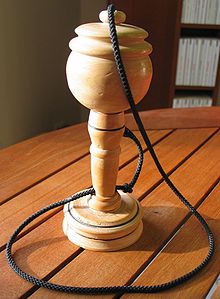Cup-and-ball

French bilboquet
|
|
| Age range | 2+ |
|---|---|
| Playing time | About 45 seconds to a few minutes per round |
| Random chance | Low |
| Skill(s) required | Hand-eye coordination |
Cup-and-ball (or ball in a cup) or ring and pin is a traditional children's toy. It is generally a wooden handle, to which a small ball is attached by a string, and which has one or two cups, or a spike, upon which the player tries to catch the ball. It is popular in Spanish-speaking countries, where it is called by a wide number of names (including boliche in Spain and balero in most of Hispanic America), and was historically popular in France as the bilboquet. A similar toy with three cups and a spike called kendama is very popular in Japan and has spread globally in popularity.
The game was created in the 16th century and has been improved in different ways since then.
In North America it was both a child's toy and a gambling mechanism for adults, and involved catching a ring rather than a ball. In some Native American tribes it was even a courtship device, where suitors would challenge the objects of their interest to a polite game of ring and pin. The Mohave variant of the game included up to 17 extra rings attached to the cord, and game scoring involved differing point values assigned to different rings. Other variants include those played by the Inuit of what is now Labrador, with a rabbit's skull in place of the ball, with extra holes bored into it, which had to be caught on the handle like a skewer; and those that used balls of grass or animal hair. Ring and pin games in general were known as ajagak, ayagak, ajaquktuk in Inuit dialects.
The cup-and-ball is noted in France as early as the sixteenth century. The game was played by King Henry III of France as historical records note, though his playing was considered evidence of his mental instability. After his death, the game went out of fashion, and for a century the game was only remembered by a small number of enthusiasts such as the Marquis de Biévre.
The game had its golden age during the reign of Louis XV — among the upper classes people owned baleros made of ivory. Actors also sometimes appeared with them in scenes. The game was very popular in the 18th and 19th centuries. Jean-Jacques Rousseau mentions the game early in his Confessions when stating his reservations about idle talk and hands, saying "If ever I went back into society I should carry a cup-and-ball in my pocket, and play with it all day long to excuse myself from speaking when I had nothing to say."
...
Wikipedia
